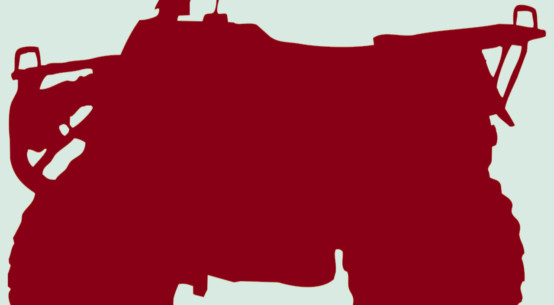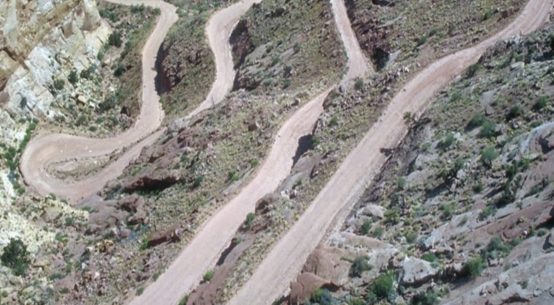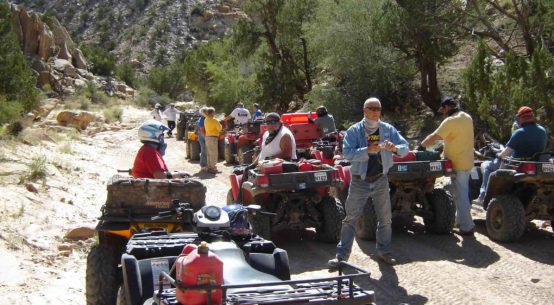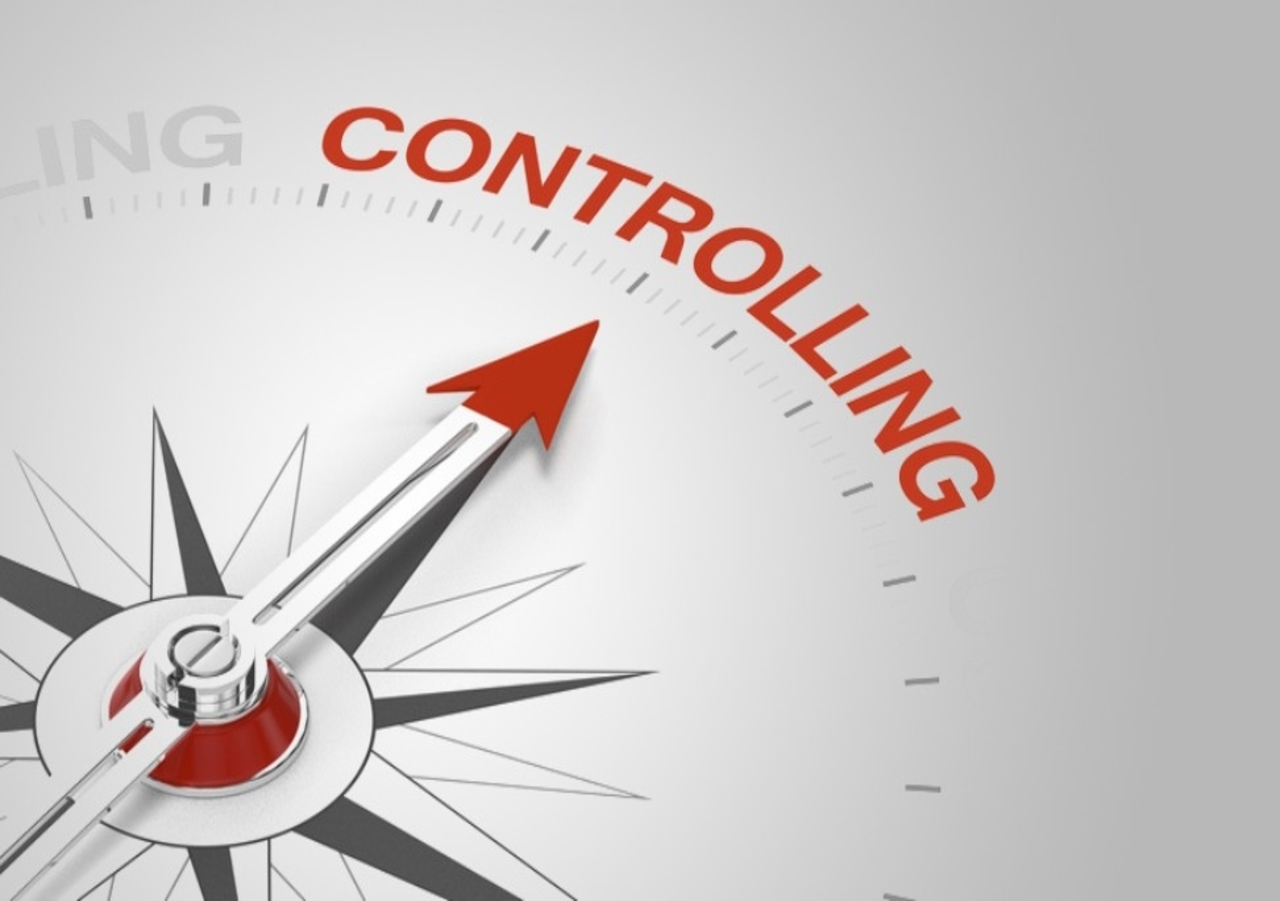
When in training, you are told that you should never ride double, tandem, or with a passenger on any machine that was not built for that purpose. This is good advice. However, it is not illegal to ride double in the State of Utah. There are a numerous reasons why people would choose to ride double, but because it is not recommended there is no effort to educate people on how they might improve the control of their ATV while riding double. This is what happens when risk avoidance outweighs common sense and practical safety.
I am not suggesting that or approving of people riding an ATV double. If a person chooses to ride double they increase the probability that they may be seriously injured or die.
Don’t Ride Double!
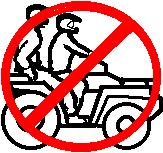 Let there be no mistake, riding double is not recommended, the practice has a higher incident of injuries, including serious disabling injuries and death. (There, is that clear enough?)
Let there be no mistake, riding double is not recommended, the practice has a higher incident of injuries, including serious disabling injuries and death. (There, is that clear enough?)
Now, that being said. The truth of the matter is, it would be a rare machine indeed if it had never been used and by operator with passenger.
However if you personally make the legal choice to ride with a passenger you assume the responsibility of doing so. Manufacturers, dealers, State Training Agencies, BLM and Forest Service, even this web site all strongly advise against riding double so don’t look to any of these entities as a responsible party in your injury liability law suit. IF YOU DO THIS AND YOU OR YOUR PASSENGER ARE INJURED OR DIE YOU ARE SOLELY RESPONSIBLE FOR THIS ACTION.
The fact that someone is willing to share opinions that may improve your control under dangerous circumstances, does not relieve you from your responsibility for your actions nor does it indicate any liability on the part of this web site owners and sponsors.
Still, riding double happens all the time, right or wrong. There are some things that may improve your chances of riding with more control when you do choose to accept the responsibility for yourself of riding double. Since improved control is the issue here and not liability, the following opinions are offered to improve the potential of greater control during such activity.
There are several considerations that increase the danger of riding double. 1.) Climbing hills. 2.) Traversing a slope that has a steep incline; 3.) Riding with children; 4.) Uneven or rough trail conditions; 5.) Hard packed surfaces.
Climbing Hills
On a flat surface a four wheel device offers the maximum stability. The undisputed stability factor quickly changes when you introduce even modest inclines to the equation. The challenge that an ATV faces that a normal car, 4×4, or SUV does not encounter is due to its short wheel base. (Wheel base is the distance between the front and the rear axle) The short wheel base makes it possible to change the center of gravity on the machine when encountering even small obstacles that are not absorbed by the shock absorbers, if already on a graduated incline.
One of the central points in climbing any hill is the CENTER OF GRAVITY. On an ATV you have the ability to manage the center of gravity. As long as you are able to keep the center of gravity between the axles of the machine, you are more likely to be able to successfully retain control of your machine.
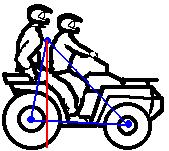 If you are able to keep the red line between the axles, you are within the “control zone” for the machine.
If you are able to keep the red line between the axles, you are within the “control zone” for the machine.
When standing the center of gravity for an ATV is usually found somewhere in the middle of the machine. The center of gravity will vary between machines based upon the weight distribution of the major components of the machine. Some manufacturers build machines with a rear mounted motor, others place them somewhere in the center of the machine. The closer to the front of the machine the heavier components (motor and transmission) are located the more favorable the distribution of weight will be for keeping the machine in the control zone. One trick that manufacturers use to improve the angle that a machine can successfully climb is to put on smaller wheels and tires on the front of the machine. This will drop the angle between the axles and thus permit a steeper hill climb. However, the added weight on a machine when riding double generally will result in compacting of the rear tire thus losing the advantage of the smaller front tire.
Have you ever noticed in the ATV hill climb magazines that ATVs are modified with the rear wheels set back additional distances? This is done to extend the wheel base and force the major weight factors to the front of the machine. This greatly enhances the angle where control permits you to climb.
The closer to the rear of the machine the center of gravity is, the more likely it is to flip over backwards. Unfortunately, the center of gravity is not marked on a machine. Actually, it is not possible to mark the center of gravity because it changes with every feature, accessory and person that is added to the machine.
Another important consideration in control is TORQUE. Torque is normally viewed as a feature. It is torque that gives you power to accelerate and the inertia to  climb a hill. Knowing when to apply power to your machine and when not to apply power is a lifesaving skill. Torque has the normal reaction to raise the front end of your machine. It is torque that permits Motorcyclists to raise their front wheel and zoom across the Five Mile Pass parking area. Racing ATVs can do the same trick. Utility ATVs are not normally inclined to do a front wheel lift for more than a few inches. Torque at the wrong moment can force the center of gravity beyond the scale of control.
climb a hill. Knowing when to apply power to your machine and when not to apply power is a lifesaving skill. Torque has the normal reaction to raise the front end of your machine. It is torque that permits Motorcyclists to raise their front wheel and zoom across the Five Mile Pass parking area. Racing ATVs can do the same trick. Utility ATVs are not normally inclined to do a front wheel lift for more than a few inches. Torque at the wrong moment can force the center of gravity beyond the scale of control.
An advantage a four wheel drive ATV has over a two wheel drive ATV is that the torque is delivered to all wheels simultaneously and equally thus reducing the amount of front wheel lift potential on the machine.
Now let’s look at the impact that the center of gravity and torque have on riding double on an ATV.
Under the most favorable conditions (riding single) you can climb some serious steep hills, but you do not enjoy that same privilege when riding double, even though you may be riding the same machine with ample power.
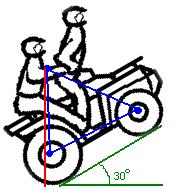 The issue is not a question of power, but the location of the center of gravity. The moment the line that runs vertically between the center of gravity on the ATV and the center of the earth crosses beyond the rear axle, the ATV will throw its front wheels off the ground. If the center of gravity is not pushed forward, the machine will tip over backwards.
The issue is not a question of power, but the location of the center of gravity. The moment the line that runs vertically between the center of gravity on the ATV and the center of the earth crosses beyond the rear axle, the ATV will throw its front wheels off the ground. If the center of gravity is not pushed forward, the machine will tip over backwards.
The mistake that many people will make when the front wheels come up, is to give the machine more gas by pressing on the throttle. This is the wrong thing to do. When the front wheels come up you need to let up on the gas and lean further forward.
As demonstrated below. When riding double both driver and passenger need to move their weight forward to maintain control of operation.
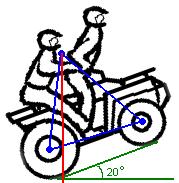 No matter how you try, you will never be able to maintain control when climbing a hill as steep as 30 degrees with a rider on back of your machine. The tandem climb shown here is a 20 degree angle. When you reach a point where the degree of ascent exceeds 25 degrees it is better for you to abandon the tandem ride and one person becomes a hiker and the other can then safely make the climb on the ATV. If it is a long hill, you may have to take alternating turns on the machine, if possible.
No matter how you try, you will never be able to maintain control when climbing a hill as steep as 30 degrees with a rider on back of your machine. The tandem climb shown here is a 20 degree angle. When you reach a point where the degree of ascent exceeds 25 degrees it is better for you to abandon the tandem ride and one person becomes a hiker and the other can then safely make the climb on the ATV. If it is a long hill, you may have to take alternating turns on the machine, if possible.
Yet another consideration of riding double is braking distance is greatly increased with added weight of a passenger on a machine. What seems like a safe distance for an experienced single rider, may not be a safe distance at all when riding double.
The skid turn, so frequently employed while riding single should be avoided altogether when riding double. This will mean that you will have to traverse trails with great caution and slow speeds.
Riding with Children
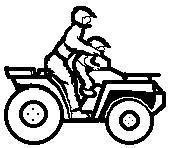 The same disclaimers stated above apply to this discussion also.
The same disclaimers stated above apply to this discussion also.
Additionally, these are unproven opinions and should a person choose to ride an ATV with a child, they do so at their own risk. This information is offered in the hope of improving the probability of more manageable control in a dangerous situation.
The law requires that all riders and passengers who are under 18 years old wear a helmet, and this writer strongly suggests that all riders wear a helmet.
Young children are the most likely passengers on ATVs. Few of these would even have the capability of driving their own machine. There are some practices that improve the control of riding with children.
 Children who ride with other children are at extreme risk and such activity should NEVER be permitted. ATV riding is a serious and dangerous sport that requires maturity and sound, instantaneous judgment at all times in order to preserve any element of control over operation of the vehicle.
Children who ride with other children are at extreme risk and such activity should NEVER be permitted. ATV riding is a serious and dangerous sport that requires maturity and sound, instantaneous judgment at all times in order to preserve any element of control over operation of the vehicle.
When an adult permits a child to be a passenger on an ATV they assume full financial and legal responsibility for injuries and fatalities to themselves and the child passenger. Under such conditions the helmeted child is more manageable when riding in front of the operator. The operator’s first responsibility is to the child and this position permits the operator to manage and control the child with the most ease and flexibility.
- Should the child fall asleep the operator may cradle the child.
- Should there be the necessity of jumping clear from the ATV the operator may do so with the child in arm in just an instant.
- If a rollover is experienced, primarily in sand, the operator may use their arms and elbows as a roll bar to help shield the child.
- The adult can use their knees to shift the weight of the child to aid in controlling the machine.
If there is any question, what-so-ever, that an adult is not capable of these actions, then there should be no consideration at all of permitting a child to ride with such an adult. It is simply not worth the risk. No amount of fun can justify the loss of a life through negligence.
The principles of maintaining control of the balance of the center of gravity on the machine, mentioned previously apply equally with children when riding as passengers.
Once again, riding with children is not recommended and anything herein should not be considered to be an approval or recommendation of any kind. However, if you choose to perform this activity, at least you will have some idea of how you may improve your chances for control.
Traversing a Slope
 Just so you understand (please forgive the over simplification), traversing a slope is the act of going across a surface where one side of the machine is not even with the other side of the machine.
Just so you understand (please forgive the over simplification), traversing a slope is the act of going across a surface where one side of the machine is not even with the other side of the machine.
Slopes can offer the same challenges with the center of gravity that you face when climbing a hill. Traversing a hill while riding double requires both people on the ATV to shift their weight to the uphill side of the ATV. If the passenger fails to shift their weight to the uphill side of the ATV the center of gravity can move beyond the scale of control and the danger of rolling to the side.
Uneven or Rough Trail
Road/Trail hazards are the name of the game with ATVs. An off highway vehicle is specifically intended to encounter road and trail hazards such as rocks, logs, dips, and bumps. This is the reason why ATVs use low pressure tires. The low pressure tires tend to absorb many of the smaller dips, bumps, rocks and logs. When riding double inertia and added weight on the machine cause the machine to act completely differently than when riding single. A person can be an expert single rider and feel as though they know nothing when they accept a passenger. The greatest dangers of uneven or rough trails when riding double is that they tend to change the angle of ascent or decent of a hill and the simple swing of the center of gravity can cause rollovers. Extra caution and slower speeds are the only means of increasing control so that if a rider discharge happens the injuries are recoverable.
Hard Packed Surfaces
A relatively smooth and dry surface gives the mistaken impression that one can increase speed without consideration of increased risk or injury. The “rider active” aspect of low pressure tires on ATVs increase an element of risk that is frequently not perceived by the operator. This is the reason why hard surfaces are not recommended for use with ATVs with one rider, let alone two. The possibility of risky situations increases exponentially with two riders on an ATV.
Just one year ago a young couple met with a fatal injury, apparently because they did not understand the principles of ATV control.
When two people are on an ATV, shifting weight of only one person can change direction of travel with no change in direction of the handlebars. Even actions as simple as waving to a passer-by may be sufficient to cause such an uncalculated response from the ATV. On a loose packed surface the ATV is designed to adjust by employing a controlled slide. On hard surfaces such slides are not possible and a rollover is frequently the result.
Due to these limitations the best solution to maintain control is to keep speed to a minimum. Hard packed surfaces should be avoided whether riding single or double. In either situation minimum speeds would always increase the greatest possibility of maintained control. When deciding what would be a reasonable speed, you must ask yourself what speed you would care to be thrust into the hard surface or pavement. The lower speeds will reduce, but not eliminate the possibility of serious injuries including death.
Summary
Please note that nowhere in this discussion has there been any reference to being able to safely ride double. This is not a safe practice. This is nothing more than identifying possible elements that may increase control in an unsafe situation. There are no representations or promises that you will actually experience fewer injuries by employing any opinions or suggestions offered herein. Common sense would permit you to judge the appropriateness of this information.


